Following Rahul Sharma's advice in the comments, I used interface callbacks to communicate up from the Child Fragment to the Parent Fragment and to the Activity. I also submitted this answer to Code Review. I am taking the non-answer there (at the time of this writing) to be a sign that there are no major problems with this design pattern. It seems to me to be consistent with the general guidance given in the official fragment communication docs.
Example project
The following example project expands the example given in the question. It has buttons that initiate upward communication from the fragments to the activity and from the Child Fragment to the Parent Fragment.
I set up the project layout like this:

Main Activity
The Activity implements the listeners from both fragments so that it can get messages from them.
Optional TODO: If the Activity wanted to initiate communication with the fragments, it could just get a direct reference to them and then call one of their public methods.
import android.support.v4.app.FragmentTransaction;
import android.support.v7.app.AppCompatActivity;
import android.os.Bundle;
import android.util.Log;
public class MainActivity extends AppCompatActivity implements ParentFragment.OnFragmentInteractionListener, ChildFragment.OnChildFragmentToActivityInteractionListener {
@Override
protected void onCreate(Bundle savedInstanceState) {
super.onCreate(savedInstanceState);
setContentView(R.layout.activity_main);
FragmentTransaction ft = getSupportFragmentManager().beginTransaction();
ft.replace(R.id.parent_fragment_container, new ParentFragment());
ft.commit();
}
@Override
public void messageFromParentFragmentToActivity(String myString) {
Log.i("TAG", myString);
}
@Override
public void messageFromChildFragmentToActivity(String myString) {
Log.i("TAG", myString);
}
}
Parent Fragment
The Parent Fragment implements the listener from the Child Fragment so that it can receive messages from it.
Optional TODO: If the Parent Fragment wanted to initiate communication with the Child Fragment, it could just get a direct reference to it and then call one of its public methods.
import android.content.Context;
import android.os.Bundle;
import android.support.v4.app.Fragment;
import android.support.v4.app.FragmentTransaction;
import android.util.Log;
import android.view.LayoutInflater;
import android.view.View;
import android.view.ViewGroup;
public class ParentFragment extends Fragment implements View.OnClickListener, ChildFragment.OnChildFragmentInteractionListener {
// **************** start interesting part ************************
private OnFragmentInteractionListener mListener;
@Override
public void onClick(View v) {
mListener.messageFromParentFragmentToActivity("I am the parent fragment.");
}
@Override
public void messageFromChildToParent(String myString) {
Log.i("TAG", myString);
}
public interface OnFragmentInteractionListener {
void messageFromParentFragmentToActivity(String myString);
}
// **************** end interesting part ************************
@Override
public void onAttach(Context context) {
super.onAttach(context);
if (context instanceof OnFragmentInteractionListener) {
mListener = (OnFragmentInteractionListener) context;
} else {
throw new RuntimeException(context.toString()
+ " must implement OnFragmentInteractionListener");
}
}
@Override
public View onCreateView(LayoutInflater inflater, ViewGroup container,
Bundle savedInstanceState) {
View view = inflater.inflate(R.layout.fragment_parent, container, false);
view.findViewById(R.id.parent_fragment_button).setOnClickListener(this);
return view;
}
@Override
public void onViewCreated(View view, Bundle savedInstanceState) {
Fragment childFragment = new ChildFragment();
FragmentTransaction transaction = getChildFragmentManager().beginTransaction();
transaction.replace(R.id.child_fragment_container, childFragment).commit();
}
@Override
public void onDetach() {
super.onDetach();
mListener = null;
}
}
Child Fragment
The Child Fragment defines listener interfaces for both the Activity and for the Parent Fragment. If the Child Fragment only needed to communicate with one of them, then the other interface could be removed.
import android.content.Context;
import android.os.Bundle;
import android.support.v4.app.Fragment;
import android.view.LayoutInflater;
import android.view.View;
import android.view.ViewGroup;
public class ChildFragment extends Fragment implements View.OnClickListener {
// **************** start interesting part ************************
private OnChildFragmentToActivityInteractionListener mActivityListener;
private OnChildFragmentInteractionListener mParentListener;
@Override
public void onClick(View v) {
switch (v.getId()) {
case R.id.child_fragment_contact_activity_button:
mActivityListener.messageFromChildFragmentToActivity("Hello, Activity. I am the child fragment.");
break;
case R.id.child_fragment_contact_parent_button:
mParentListener.messageFromChildToParent("Hello, parent. I am your child.");
break;
}
}
public interface OnChildFragmentToActivityInteractionListener {
void messageFromChildFragmentToActivity(String myString);
}
public interface OnChildFragmentInteractionListener {
void messageFromChildToParent(String myString);
}
@Override
public void onAttach(Context context) {
super.onAttach(context);
// check if Activity implements listener
if (context instanceof OnChildFragmentToActivityInteractionListener) {
mActivityListener = (OnChildFragmentToActivityInteractionListener) context;
} else {
throw new RuntimeException(context.toString()
+ " must implement OnChildFragmentToActivityInteractionListener");
}
// check if parent Fragment implements listener
if (getParentFragment() instanceof OnChildFragmentInteractionListener) {
mParentListener = (OnChildFragmentInteractionListener) getParentFragment();
} else {
throw new RuntimeException("The parent fragment must implement OnChildFragmentInteractionListener");
}
}
// **************** end interesting part ************************
@Override
public View onCreateView(LayoutInflater inflater, ViewGroup container,
Bundle savedInstanceState) {
View view = inflater.inflate(R.layout.fragment_child, container, false);
view.findViewById(R.id.child_fragment_contact_activity_button).setOnClickListener(this);
view.findViewById(R.id.child_fragment_contact_parent_button).setOnClickListener(this);
return view;
}
@Override
public void onDetach() {
super.onDetach();
mActivityListener = null;
mParentListener = null;
}
}

